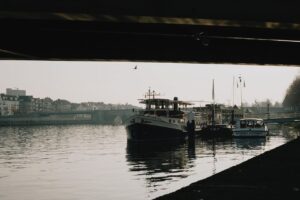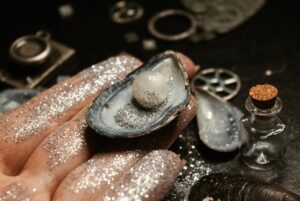The pearling industry for the Kimberley region started back in 1861 off the coast of Broome when the pearl oyster Pinctada maxima were discovered in the waters of Roebuck Bay. Back then it was the largest pearly shell in the world and very sought after, after its discovery. At this time when pearls were first discovered they were only used for buttons, cutlery handles, and a few other objects that were made from ‘mother of pearl’, and it was the pearl shell that was most precious not the actual pearl inside. If someone came across a pearl it was only seen as an added bonus.
Over the years Broome slowly came alive with some people making their way to these shores and setting up camp to claim their slice of the pie. From the 1860s through to the 1880’s all of the diving was done by the Aboriginal men and women who had been caught and put into slavery to do all of the work. They were diving to around 12 meters at a time and were made to work in unfavourable conditions which subjected them to dangerous conditions and many died as a result. There were chained up and marched to the shore where they were dragged onto pearling boats and asked to do countless dives each day.
Once the shallow waters of Roebuck Bay were emptied from the continuous pearl diving it was finally agreed upon that better diving equipment had to be introduced which then saw the demand for Aboriginal men and women decrease and finally after time they were released and let go. It was then in 1883 that the official recognition of Broome came and was declared a township by Sir Frederick Napier Broome who was then the Governor of Western Australia. The location of Broome being right on the coastline of Western Australia helped dramatically with the growing pearling industry and its exports.
In 1900 the town of Broome had grown and support a fleet of around 400 pearl luggers and a population of approximately 4000 people consisting of whites and Asians. Many people came to claim their slice but many also saw their fate with the occupational hazards that came along with the job such as sharks, cyclones, the ‘bends’, and drowning. Chinatown which still today remains in Broome is evidence of the stronghold that the Asians had in Broome and they also had the reputation to be the best at pearl diving.
The past and history of the pearly industry of Broome have made the town what it is today, fascinating, multicultural, and historic in its own right! At this point, in the early 1900s, Broome was storming ahead with the pearling industry with more than 80% of the world’s mother of pearly coming straight from Broome.
The pearling industry of Broome survived through many turbulent years and carried on through WWI and WW2 but when the plastic button was created the market came to a grinding halt. But years later experiments were conducted by the Japanese who cultured the pearls and phenomenal discoveries were made. This put Broome back on the map in regards to the pearling industry and many years later saw that over 70% of the world’s large cultured pearls were produced just offshore in Kimberley. You can take a tour of the pearl factory and industry and get your own insight into the historic mark that this industry made upon Broome and maybe even pick up your own pearl to take home.


